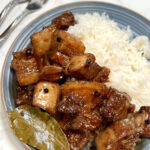Tan Tan ramen is a spicy Japanese noodle soup with Chinese origins. It’s rich and creamy with a spicy kick, perfect for those cravings of a warm bowl of ramen.
What is tan tan ramen?
Tan tan ramen is a Japanese variation of the Chinese Sichuan dish dandanmian, or dandan noodles.
The Japanese version follows a similar path to standard ramen. You get your tare (the seasoning element) in the form of sesame paste, your broth in the form of stock and milk, and finally your ramen noodles and choice of toppings (typically ground meat and greens).

Much of the Chinese influence from this dish, apart from its origin, also comes in the form of doubanjiang -a spicy fermented chili bean paste (more on that ingredient below). Mixed along with the ground meat, the paste gives food a complex, umami, and spicy kick.
In terms of difference, dan dan noodles tend to be more on the drier side, relying on a thick, sesame-based sauce to coat its noodles (though there can be more soupy variations depending on who’s preparing the dish). Tan tan ramen, on the other hand, involves a rich soup that you can slurp on.

Ingredient notes
I wanted to quickly point out two of the ingredients that are particular to making Tan Tan Ramen:
Sesame Paste

You can find the Chinese and Japanese variations of sesame paste in most Asian supermarkets. They’re super versatile and widely used in making dipping sauces for hot pot, salad dressings, or in this case, noodles.
A common substitute is tahini, though the main difference between the two is that Chinese sesame paste is made with toasted sesame seeds, while tahini is made with raw seeds. The resulting flavor profiles are strikingly different, with the Chinese version being more on the darker, toastier side.
(Popular brands I like to use are either Watson or Wangzhihe)
Doubanjiang

Again, this can also be found in most Asian supermarkets. The name is usually interchangeable along the lines of “chili bean paste” or “spicy bean sauce”, but they all typically refer to the same thing.
In a pinch, most people would recommend to use gochujang, a similar Korean fermented chili paste. They’re not exactly identical in flavor, but I’d imagine it would still taste pretty good in this recipe.
Instructions for tan tan ramen
Prepare the tare (seasoning base):
Combine all the ingredients together and mix until smooth.
Divide the mixture evenly into two bowls and set aside.

Prepare the broth:
In a sauce pot, combine together the chicken stock and non-dairy milk. Mix well.
Bring to a low simmer, then cover and keep warm until ready to serve.

Prepare the pork mixture:
Heat the oil in a pan over medium heat. Add in the ground pork and cook until no longer pink, stirring frequently to avoid burning.

Add in the ginger, garlic, and doubanjiang. Stir to coat the pork and saute until the aromatics are fragrant, about 2 minutes.
Add in the mirin, soy sauce, and sugar. Stir to combine and continue cooking until most of the liquid has evaporated, about 2 more minutes. Set aside and keep warm.

Prepare the toppings:
To a pot of boiling water, blanch your leafy greens for about one minute or until bright green and tender. Remove from the water, drain, and reserve for assembly.
Bring the water to a boil again, and cook the ramen noodles according to packaged instructions until softened with a slight chew.
To assemble:
Divide the warmed broth between your two bowls. Mix well to evenly incorporate the tare with the broth.

Add in a serving of ramen noodles to each bowl. Top with the ground pork mixture, blanched leafy greens, scallions, ramen egg, and a drizzle of chili oil, if desired. Serve immediately.

Looking for more noodle recipes? Here’s a couple you might enjoy:
Disclosure: Some links on this page are affiliate links, meaning that at no additional cost to you, we may receive compensation from purchases made through these links. As an Amazon Associate, I can earn from qualifying purchases.







